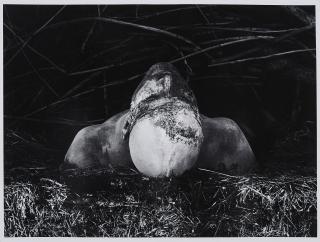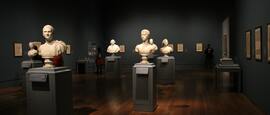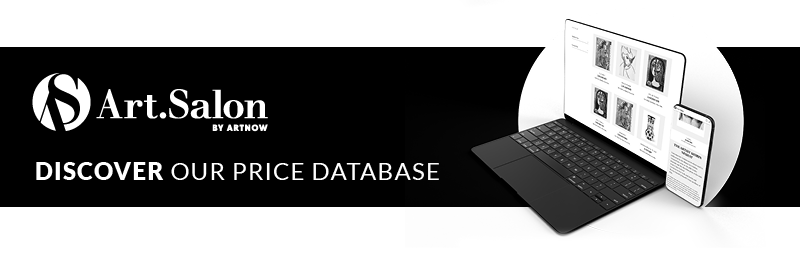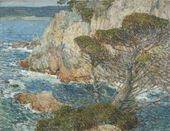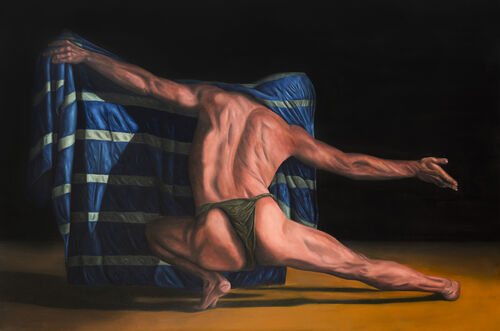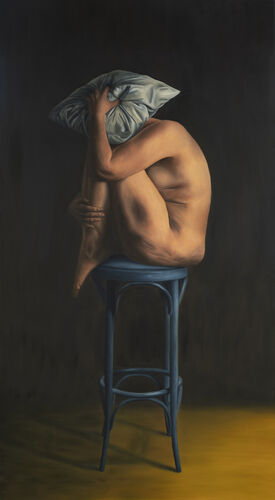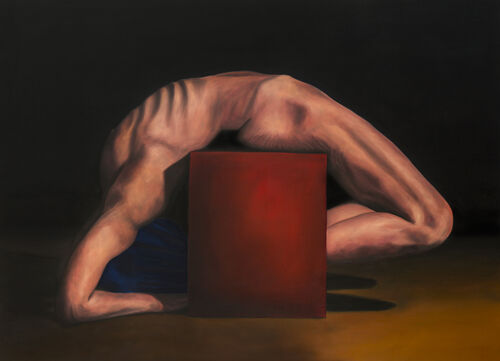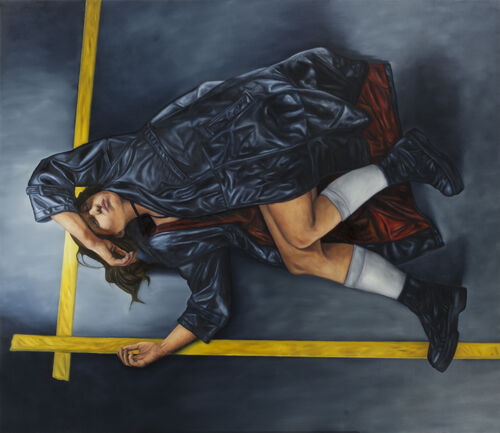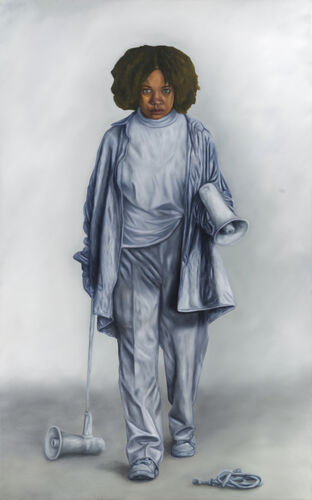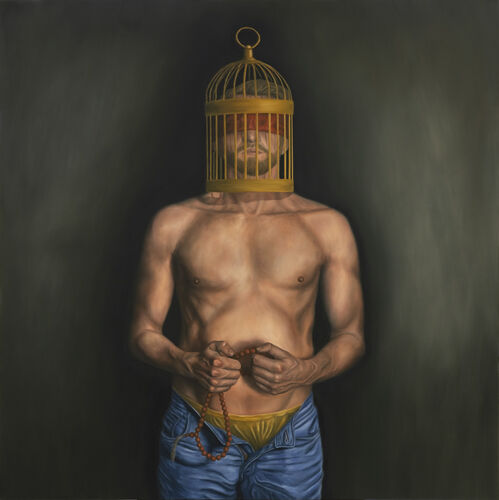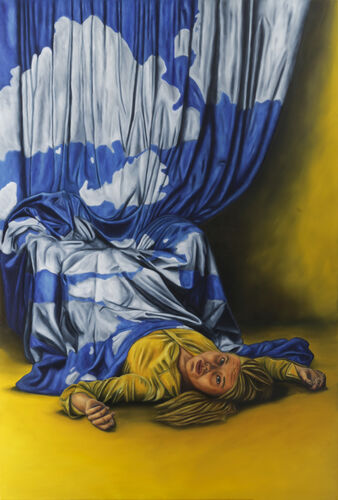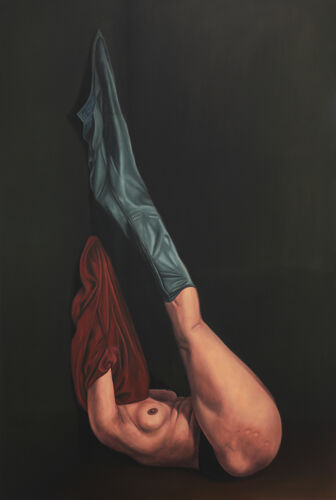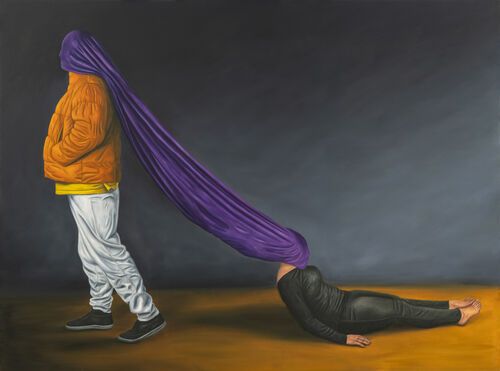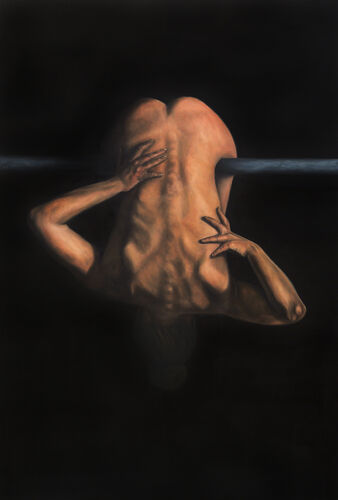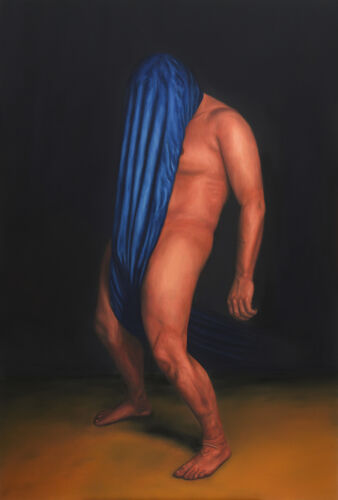A man lies powerless under a thorn bush, his face covered with dirt, his head white as a bone. An eerie-looking focal point in an otherwise somber image. The man appears trapped, seemingly being crushed - or perhaps already dead. This black-and-white photograph from the series Erinnerungsspur from the late 1970s was taken by Dieter Appelt, who himself stepped in front of the lens. The image is typical of his first creative phase from about 1960 to the mid-1980s, in which he staged his body as a tool for self-flagellation and devoted himself to the themes of death, transience, and rebirth. In another image from the Moorbegehung series, a man squats naked on an unstable scaffolding of thin tree trunks in a moorland landscape, his gaze fixed on the still but threatening water. A primal man, crouching like a creature, seeking protection with all means at his disposal. He is not left with many options, as the scaffolding proves.
Photography as time sculpture
In his photographs, Dieter Appelt is interested not in the quick, not in the image, but in the existential search for the inner self. About a remarkable oeuvre of the 1970s and 80s that links photography and performance.
Appelt was born in Niemegk, Brandenburg, in 1935 and, in addition to studying singing, also studied experimental photography with Heinz Hajek-Halke. Initially, Appelt acted as a singer at the Deutsche Oper Berlin for 18 years before turning fully to the visual arts in 1979. Appelt is both a photographer and an action artist; his work is deeply influenced by childhood memories of the Second World War. In the photographs, his body is covered in marble dust, plaster, or mud; he appears mummy-like, hanging from the ceiling by his feet or clamped into technical apparatus.
»I want to unmask time in a picture«, Appelt says of his work. »I'm concerned with superimposing a sequence of movements in a single image. I use time like a mechanic, constantly assembling memories and current experiences on top of each other... in a kind of time montage.« One of Appelt's best-known works − Der Fleck auf dem Spiegel, den der Atemhauch schafft (1977) − exemplifies his concern: The shots of his breath on a mirror dissect a fleeting moment into concrete individual actions.
Photography of the Postwar Period
When these photographs were taken, many European museums were just beginning to build photographic collections. In some cases, photography still had the reputation of not being an art form. After the end of the war, there was no way around the subjective photography of Otto Steinert in Germany, who, like Appelt's teacher Hajek-Halke, belonged to the avant-garde working group fotoform. It took up the creative photography of the 1920s, which had been suppressed during the National Socialist regime, and adopted current international trends. »Subjective photography means humanized, individualized photography, means handling the camera in order to wrest pictorial views from individual objects that correspond to their essence«, says Steinert.
In contrast to this, from the 1960s onward, are the exact, serial representations of Bernd and Hilla Becher. Their photographs of the condition of buildings in the dwindling coal industry represent an objectifying perspective that is slowly gaining acceptance in photography. In the late 1970s, they taught the Düsseldorf Photo School, which included many now-famous photographers such as Andreas Gursky, Candida Höfer, Thomas Ruff, and Thomas Struth. Dieter Appelt's interest in photography differs considerably from both currents, is more image-creative and experimental, less object-oriented.
Appelts special method
Appelt deals with death and trauma as a result of World War II and takes a look at the past that people, especially in Germany at the time, did not want to see. His interweaving of photography and performance, which he called »actions« after Joseph Beuys, embodies an approach that stood between popular art movements much discussed in the media. The presence of Beuys, whose head covered with honey and gold dust in the action Wie man dem toten Hasen die Bilder erklärt (1965) was certainly formative for Appelt, dominated media interest. Away from the media presence, Appelt found an individual way for dealing with secretive topics − always a sign of great art.
»I don't appreciate so much the depiction or the speed of photography, which has its undisputed value, which I also don't doubt in any way; but, if I want to get to a picture, then I basically even have the same possibilities as a painter has. And with that, of course, I tread a path that has to do with something internal, with something I note, so to speak, a passage of time, I probe something that has to do with death, of course«, Appelt said in a 2009 interview.
Beginning in the mid-1980s, a few years after Appelt was appointed professor of film, video, and photography at Berlin's Hochschule der Künste, his work became more abstract and methodical: rotating objects, landscapes, and architecture now function as motifs. In his tableaus, which consist of several hundred individual photographs of a bridge, for example, Appelt experiments with the process of photography itself. He expands the visual perception of man, which the eye is not able to offer.
Retrospective and current drawings
Critics dubbed Appelt's major retrospective at the Art Institute of Chicago in 1994, which was also on view in New York, New Orleans, Québec, and Berlin, the highlight of the year. The sinister, complex photographic works were fascinating and reminiscent of a scientific investigation because of their borrowings: they do not romanticize horror, yet they are expressive, arousing interest rather than fear. Appelt participated twice in the Venice Biennale in the 1990s. He is regarded as a seeker whose contribution to German art history was more readily understood abroad than in his homeland − because he did not close himself off to the past, but tried to fathom it in a new way.
In recent years, Appelt has returned to his starting point, the world of music and sound. He makes drawings for which he has a sound image in mind during the process of creation. Sound and line work influence each other and together form a work of art. Appelt's drawings, however, can also be seen as independent works that refer to an unknown »more«. The soundtrack is not based on classical instruments, but on noises and vibrations, which Appelt compares to recorded space sounds made by NASA. A special device scans the drawings with a laser beam and creates the sound images with light and dark areas and the thickness of the hatching. Appelt once again enters an unknown world that he has set himself the task of exploring.
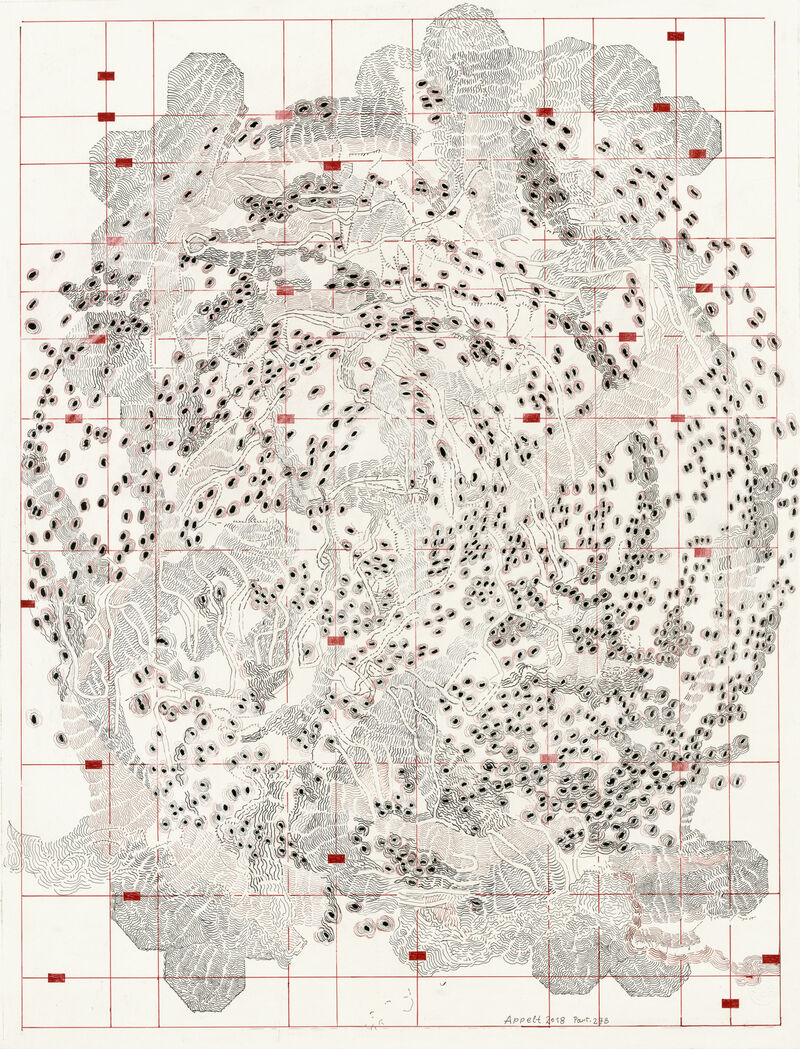
More on the subject Features
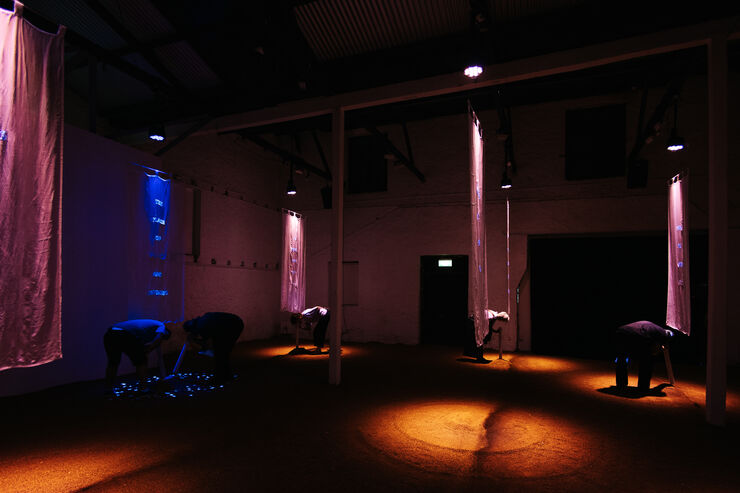
Carried by the land – in search of home
From November 13 to 30, the Fremantle Biennale took place in Australia near Perth, focusing on site-specific contemporary art. Among the exhibiting artists was Raki Nikahetiya with a sensory installation about the intertwining of identity, displacement, and home.
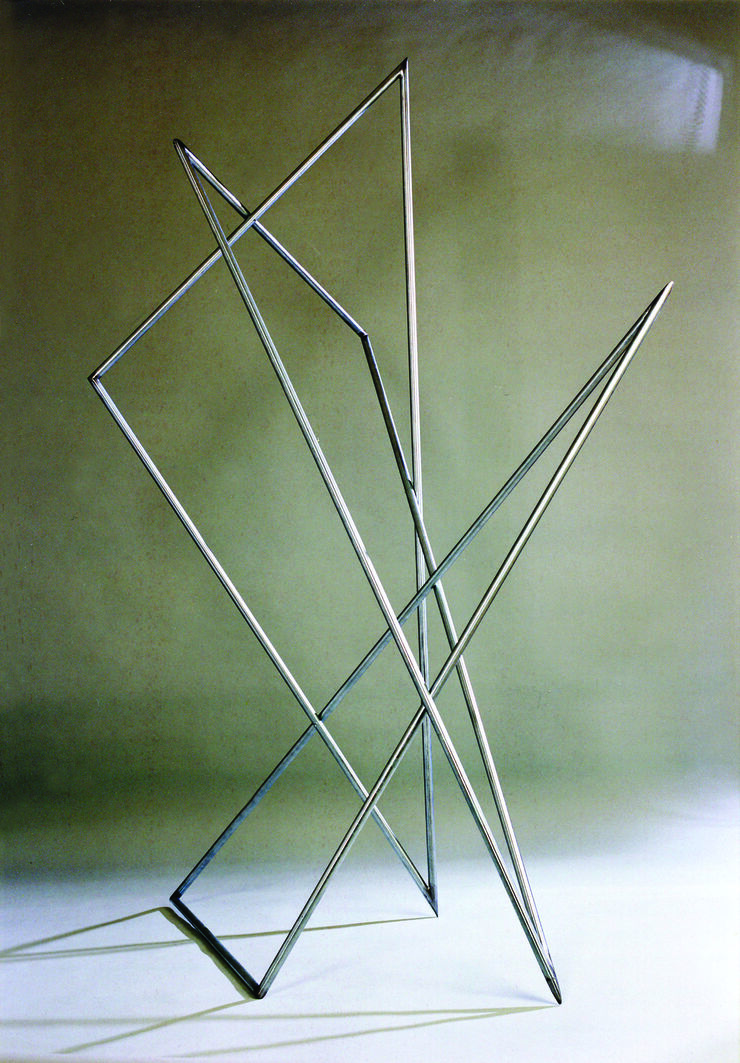
Elementary forms of life: Ria Groenhof's sculptural visual language
Dutch artist Ria Groenhof, who also uses the artist name Atelier 85, has been working as a freelance artist for 40 years. Whether monumental sculptures in public spaces or paintings on canvas, her work combines the clarity of geometry with existential questions. The Art.Salon presents the artist's multifaceted oeuvre.
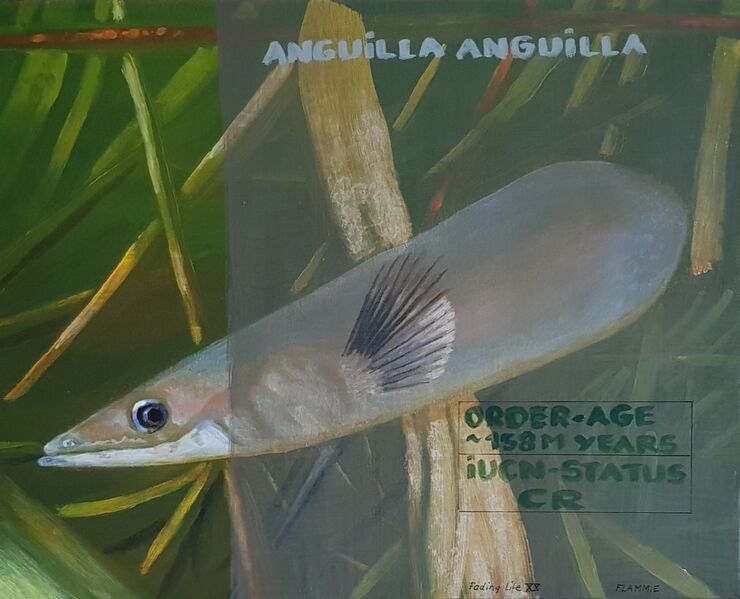
Painting for the preservation of biodiversity
From November 14 to 27, Elvira Flamm from the Art.Salon artist program will be exhibiting eight works from her Fading Life series at the Charity Art Gallery in Stockholm, in which she addresses endangered animal and plant species. The works are for sale, with 10% of the proceeds going to the World Wide Fund For Nature (WWF). The artist herself is donating an additional 20%.
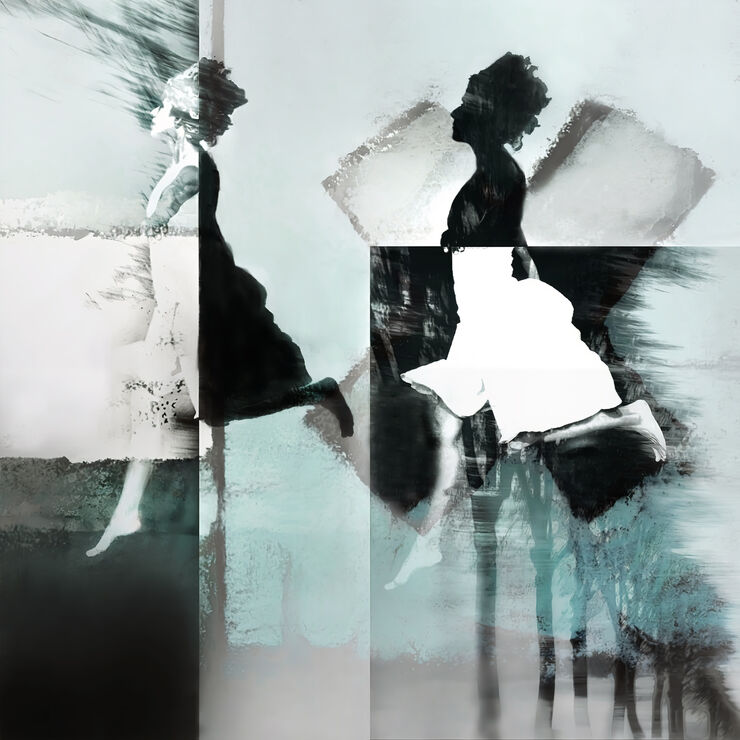
Between dissolving and becoming
Petra Jaenicke's photographic works defy quick reading. They are poetic illusions, analyses of an always subjective reality, shaped by experiences and emotions. Under the term »deconstructivist photography«, the artist reveals new levels of perception in her multi-layered photo collages.
Dive deeper into the art world
Staged Realities
For the first time in over 25 years, there is another major exhibition on Jeff Wall in Canada: the Museum of Contemporary Art Toronto is presenting over 50 works by the renowned artist in Jeff Wall Photographs 1984–2023. The exhibition runs until March 22, 2026.



